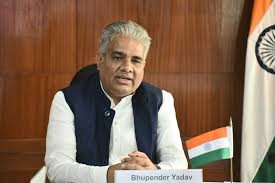At inaugural assembly, Big Cat Alliance endorses Bhupender Yadav as president

In a historic step for wildlife conservation, the Big Cat Alliance (BCA) endorsed India’s Union Environment Minister Bhupender Yadav as its first president. The appointment came during the Alliance’s inaugural general assembly, which brought together nations, scientists, and conservation groups to plan the future of big cat protection worldwide.
India Steps Forward in Global Conservation
The BCA was originally proposed by Prime Minister Narendra Modi in 2019. He introduced the idea during the Global Tiger Day event, with the aim of strengthening global efforts to protect seven big cat species: tiger, lion, leopard, snow leopard, jaguar, cheetah, and puma.
India, home to over 70% of the world’s wild tigers, has played a key role in these efforts. The country now leads the way by offering its experience, innovation, and success stories to the world.
Accepting the role, Yadav said, “India is proud to lead this effort. With more than 70% of the world’s wild tiger population, we are ready to share our expertise and conservation models globally.”
Why Bhupender Yadav?
Yadav’s selection as president was widely supported. Since becoming Environment Minister in 2021, he has led major conservation programs. His leadership helped increase India’s tiger population to 3,167 in 2022. Additionally, under his guidance, India reintroduced cheetahs after 70 years, a bold move to revive lost biodiversity.
Moreover, Yadav has promoted community-based conservation and better use of wildlife technology. These achievements made him an ideal choice to lead the Alliance.
A Shared Mission for Big Cats
The first assembly included representatives from many countries. Global organizations such as WWF, UNEP, and CITES also participated. Delegates discussed ways to improve cooperation across borders and protect big cat habitats more effectively.
Key goals include:
- Linking wildlife corridors across nations
- Using AI and camera traps to monitor animals
- Sharing anti-poaching intelligence
- Supporting local communities that live near big cat habitats
Several countries showed interest in following India’s Project Tiger and Project Lion models. Clearly, the BCA wants to turn national success stories into global action plans.
India’s Track Record in Conservation
India’s wildlife conservation journey is seen as a global success. Since launching Project Tiger in 1973, India has expanded protected reserves and reversed declining tiger numbers. The latest tiger census, based on AI-driven camera traps, has set a new global benchmark.
Recently, India also launched the Cheetah Reintroduction Project at Kuno National Park in Madhya Pradesh. This was the first time cheetahs were brought back to India after going extinct in the 1950s.
A Vision for the Future
Under Bhupender Yadav’s leadership, the Big Cat Alliance will:
- Create shared platforms for data and research
- Build international big cat corridors
- Fund local conservation jobs and eco-tourism
- Help countries with fewer resources join the global effort
India also proposed the creation of a Global Big Cat Conservation Fund. This fund will support nations that have big cat populations but lack money or technology.
Yadav emphasized, “No country should be left behind. Conservation must be inclusive and collaborative.”
Worldwide Support for India’s Role
The decision to name an Indian leader as BCA president received praise from many. Groups like UNEP and IUCN called it a sign of India’s rising leadership in global environmental issues.
Dr. Krithi Karanth, a respected conservation biologist, added, “Big cats are umbrella species. Protecting them means protecting entire ecosystems.”
Clearly, this appointment is more than symbolic. It reflects growing trust in India’s ability to guide global environmental efforts.
Conclusion
The appointment of Bhupender Yadav as president of the Big Cat Alliance signals a strong start for global big cat protection. With India leading the way, the Alliance hopes to restore balance to fragile ecosystems and prevent the extinction of these majestic predators.
As threats like poaching and habitat loss grow, this collaboration offers hope. The world is now watching the Big Cat Alliance take its first big steps—and with the right leadership, the future looks promising.






